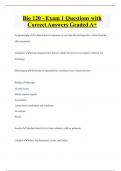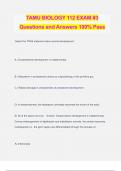Cnidaria Study guides, Class notes & Summaries
Looking for the best study guides, study notes and summaries about Cnidaria? On this page you'll find 198 study documents about Cnidaria.
Page 4 out of 198 results
Sort by

-
Principles of Biology (Biol 198) Exam Questions And Answers (Updated And Verified)
- Exam (elaborations) • 29 pages • 2024
-
- $13.49
- + learn more
Principles of Biology (Biol 198) Exam Questions And Answers (Updated And Verified) _____ is a type of connective tissue and _____ is a type of epithelial tissue. - answerBone; lining of the digestive tract What is the top side of a vertebrate and other bilateral organisms? - answerDorsal side What is the bottom side of a vertebrate and other bilateral organisms? - answerVentral side Germ layer on the outside layer of the body. Forms skin and nervous system (nerves). - answerEctoderm The...

-
Bio 120 - Exam 1 Questions with Correct Answers Graded A+
- Exam (elaborations) • 39 pages • 2024
- Available in package deal
-
- $12.99
- + learn more
Bio 120 - Exam 1 Questions with Correct Answers Graded A+ Synapomorphy A shared derived character or trait state that distinguishes a clade from the other organisms. Analagous Having characteristics that are similar because of convergent evolution, not homology. Homologous Similarity in characteristics resulting from a shared ancestry. Porifera Sponges No true tissues Mostly marine, aquatic Asymmetric 2 germ layers (endoderm and ectoderm) No coelom Sessile Sessile Attached direc...

-
TAMU Biology 112 Lab Practical 2 Exam Questions and Answers 100% Pass
- Exam (elaborations) • 23 pages • 2024
- Available in package deal
-
- $12.49
- + learn more
TAMU Biology 112 Lab Practical 2 Exam Questions and Answers 100% Pass Phylum Porifera - Answer- No true tissues Asymmetrical symmetry Taxa: -Silicea (glass sponges) -Calcarea (rest of sponges) Osculum - Answer- Water exit in sponges Spicules - Answer- -Skeletal components of sponges made of silica, calcite or spongin -Produced by amoebocytes Choanocytes - Answer- Spong's filter-feeding cells Phylum Cnidaria - Answer- Diploblastic Radially symmetrical Cnidocytes Classes: -Anthozoa...

-
TAMU BIOLOGY 112 EXAM #3 Questions and Answers 100% Pass
- Exam (elaborations) • 33 pages • 2024
- Available in package deal
-
- $13.49
- + learn more
TAMU BIOLOGY 112 EXAM #3 Questions and Answers 100% Pass Select the TRUE statement about animal development: A.) Deuterostome development is indeterminate. B.) Mesoderm in protostomes arises as outpocketings of the primitive gut. C.) Radial cleavage is characteristic of protostome development. D) In deuterostomes, the blastopore ultimately becomes the mouth of the adult. E) All of the above are true. - Answer- Deuterostome development is indeterminate. During embryogenesis of diploblasti...

-
Bio 1402 Chapter 33 Questions and Answers Rated A+
- Exam (elaborations) • 8 pages • 2024
- Available in package deal
-
- $9.99
- + learn more
Bio 1402 Chapter 33 Questions and Answers Rated A+ Schistosomiasis is a serious disorder afflicting humans mainly in tropical regions; it is caused by a fluke. The long, flat bodies of tapeworms are made up of repeating segments known as proglottids. Which of the following is not true about beef tapeworms? more than 10% of the cattle are infected in the United States Which of the following is not true about pseudocoelomates? They contain a bony skeleton. Which of the followin...

-
Biology 1402 Questions and Answers Already Passed
- Exam (elaborations) • 9 pages • 2024
- Available in package deal
-
- $9.99
- + learn more
Biology 1402 Questions and Answers Already Passed What is a feature of Animals, but is not seen outside of the animal kingdom? They have collagen in their extracellular matrix. Phylogenies based on morphology and phylogenies based on molecular data disagree on which one of the following issues? whether the appearance and type of coelom is important in interpreting phylogeny A horshoe-shaped crown of tentacles used by many invertebrates for feeding is called a lophophore Which ...

-
Kingdom Animalia: Porifera, Cnidaria, Platyhelminthes, Nematoda Exam Questions and Answers
- Exam (elaborations) • 3 pages • 2022
-
- $9.99
- + learn more
Phylum Porifera - ANSWER simple, sessile (permanently attached to one location) sponges; no tissues, organs, mouth or digestive cavity; filter feeders: flagellated collar cells line the large internal cavity and draw water into the sponge (food particles are strained out of the water current by the collar cells which pass food to other sponge cells); acolemate (no colon); no symmetry; most are marine Phylum Cnidaria - ANSWER class hydrozoa, class scyphozoa, class anthozoa; jellyfish, sea anem...

-
WSU Biology 106 Exam 3 >> Questions and Answers Updated | 2024
- Exam (elaborations) • 14 pages • 2024
-
- $12.49
- + learn more
WSU Biology 106 Exam 3 >> Questions and Answers Updated | 2024 Spongocoel the large central cavity of sponges. water enters the spongocoel through tiny pores called ostia and it exits through the large opening called the osculum. spongocoel is lined with choanocytes which help to create a current in the water. Spicule structural elements found in most sponges. They provide structural support and deter predators. Large ones are called megascleres while microscopic ones...

-
BIOL 198 Module 7 Exam Questions With 100% Correct Answers
- Exam (elaborations) • 18 pages • 2024
- Available in package deal
-
- $12.49
- + learn more
BIOL 198 Module 7 Exam Questions With 100% Correct Answers Identify the characteristics that distinguish animals from other types of organisms. - answerMulticellular Heterotrophic Motile Reproduce sexually Use aerobic metabolism Lack cell walls Have life cycles that include development from undifferentiated cells Have a variety of body plans Distinguish between asymmetry, radial symmetry, and bilateral symmetry. - answerAsymmetry: no particular organization Radial symmetry: Circular...

-
Principles of Biology (Biol 198) Exam Questions And Answers (Updated And Verified)
- Exam (elaborations) • 29 pages • 2024
-
- $13.49
- + learn more
Principles of Biology (Biol 198) Exam Questions And Answers (Updated And Verified) _____ is a type of connective tissue and _____ is a type of epithelial tissue. - answerBone; lining of the digestive tract What is the top side of a vertebrate and other bilateral organisms? - answerDorsal side What is the bottom side of a vertebrate and other bilateral organisms? - answerVentral side Germ layer on the outside layer of the body. Forms skin and nervous system (nerves). - answerEctoderm The...

That summary you just bought made someone very happy. Also get paid weekly? Sell your study resources on Stuvia! Discover all about earning on Stuvia


